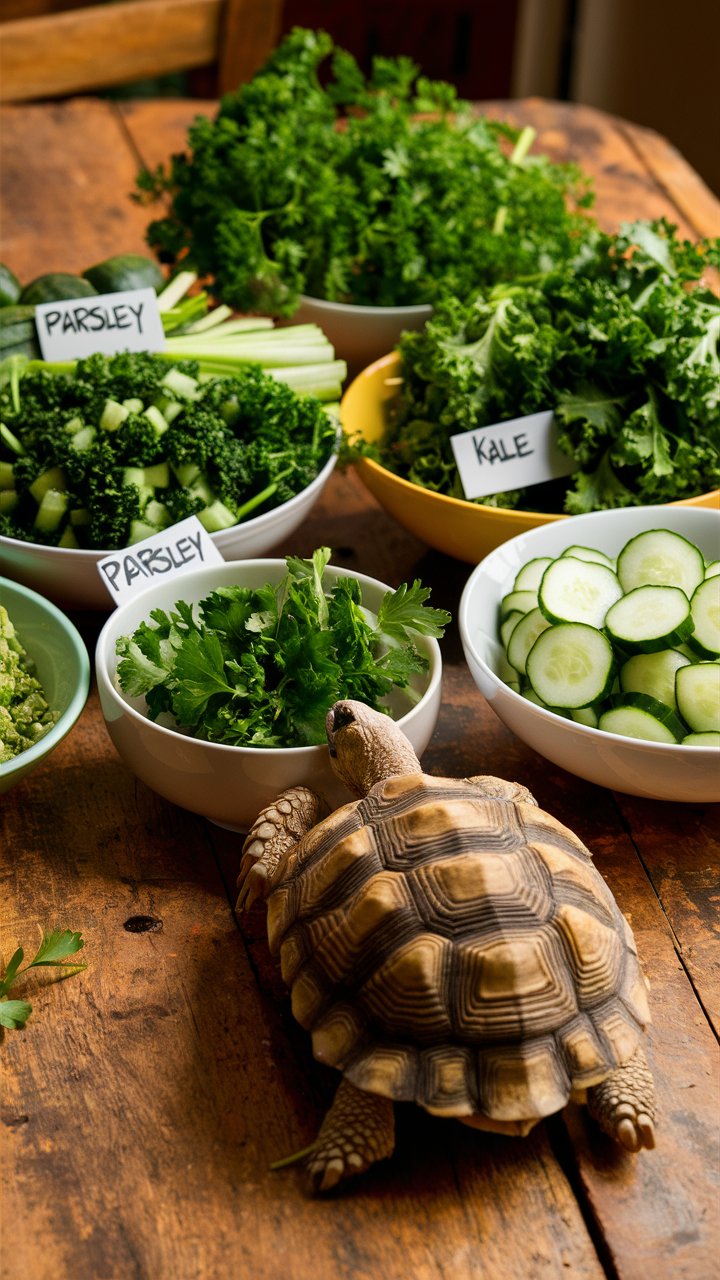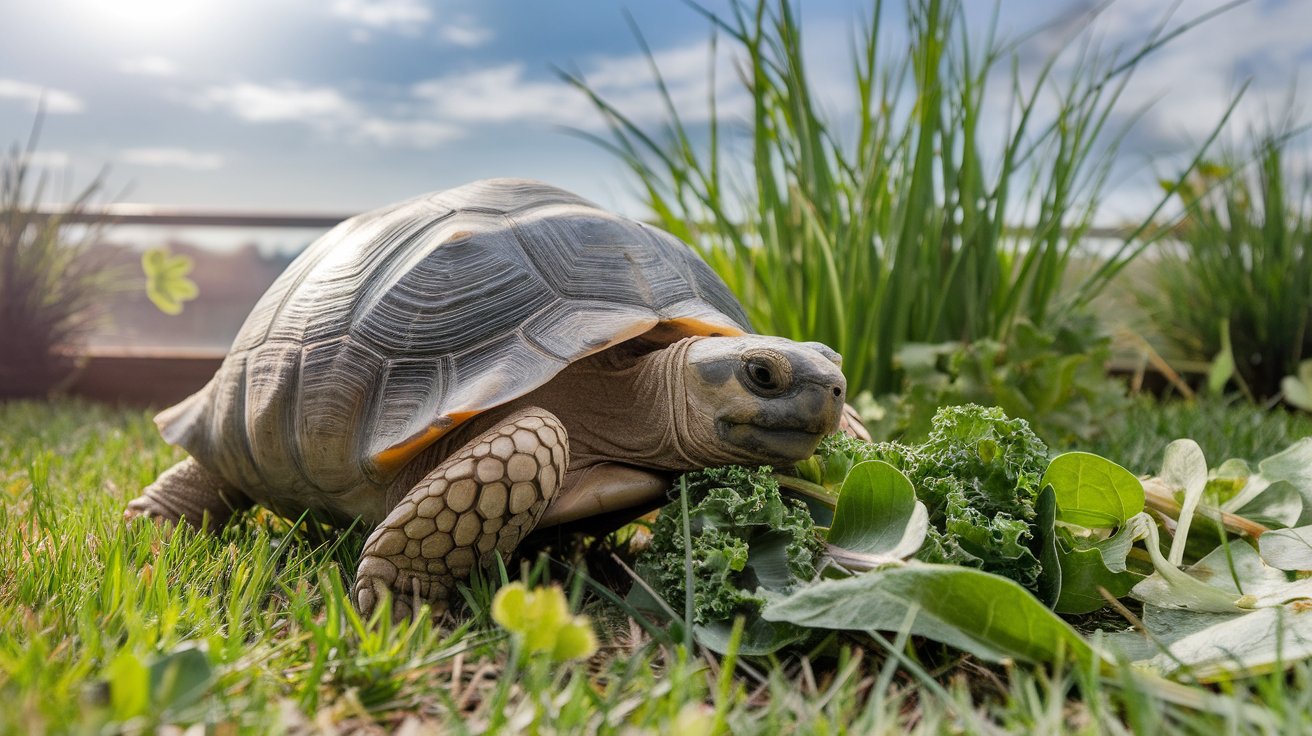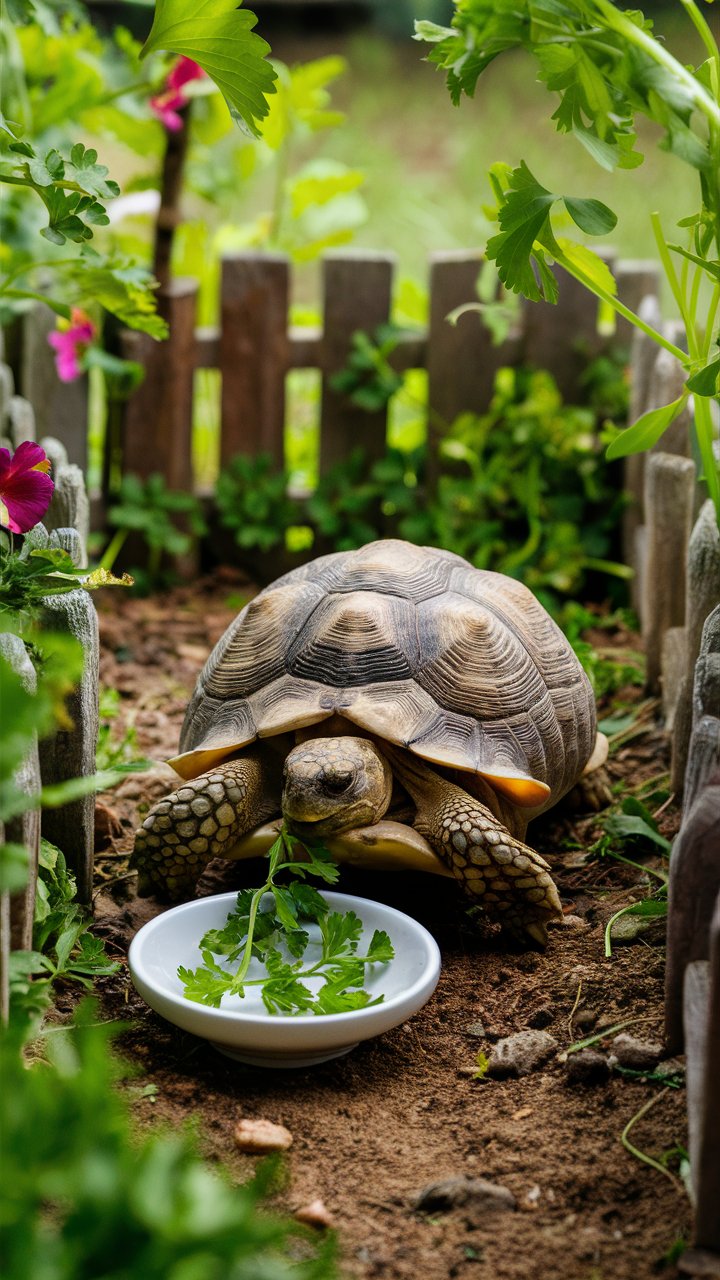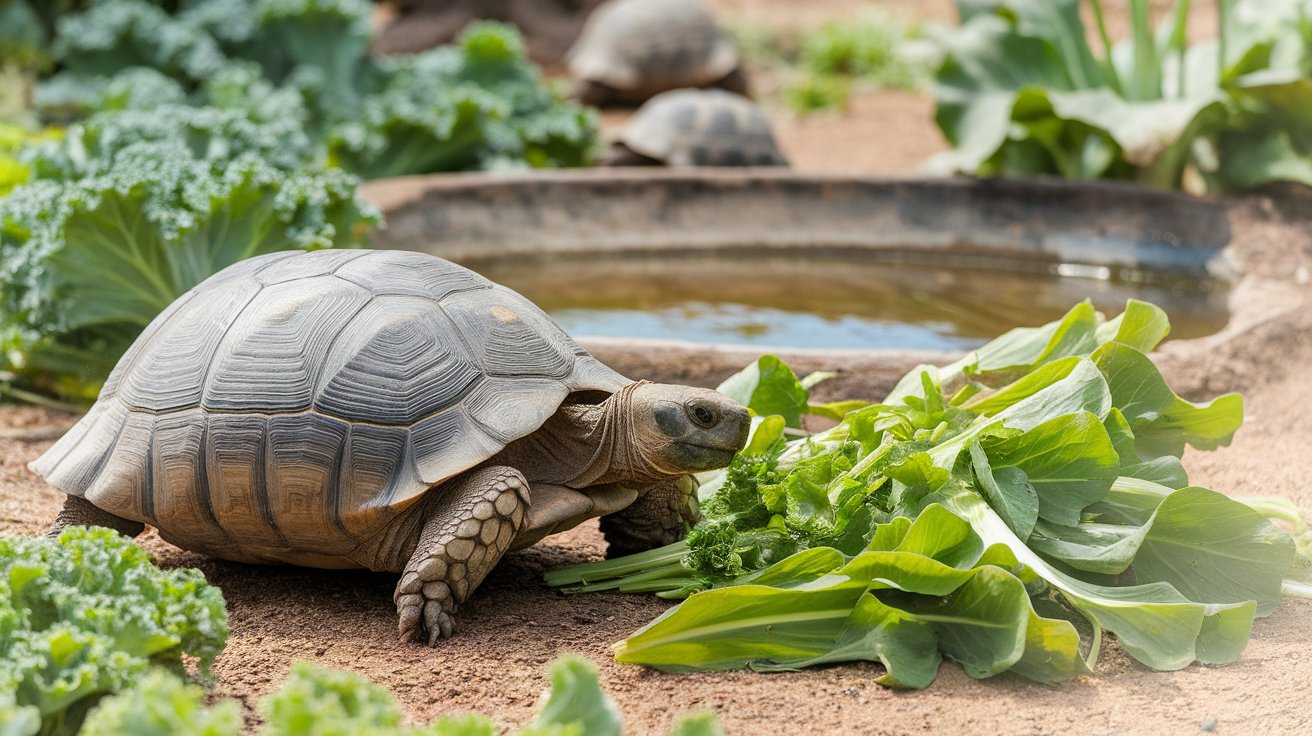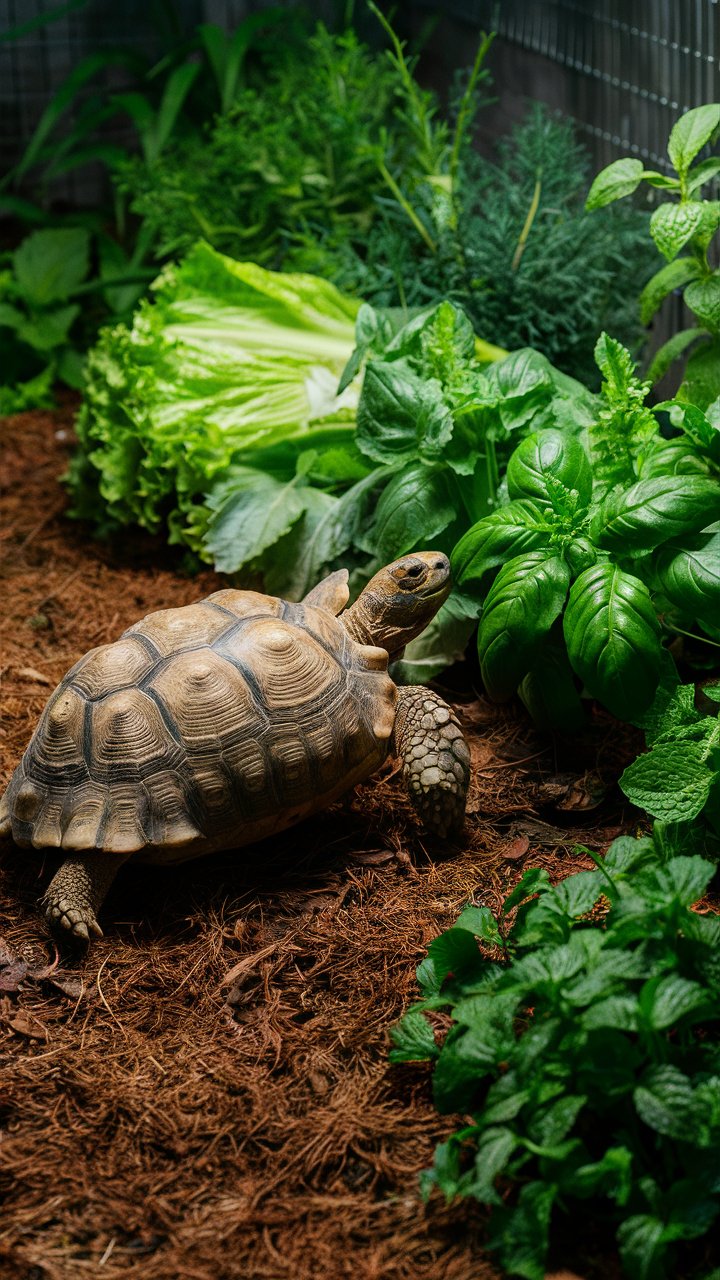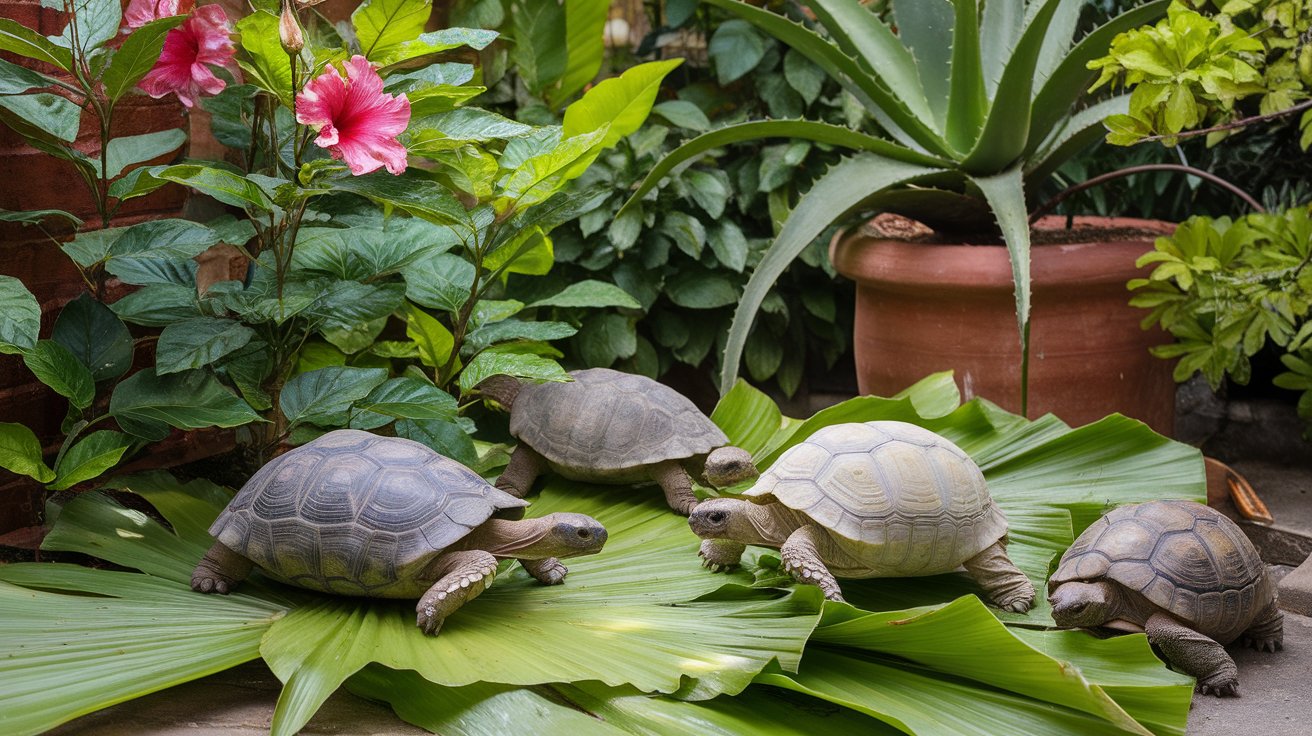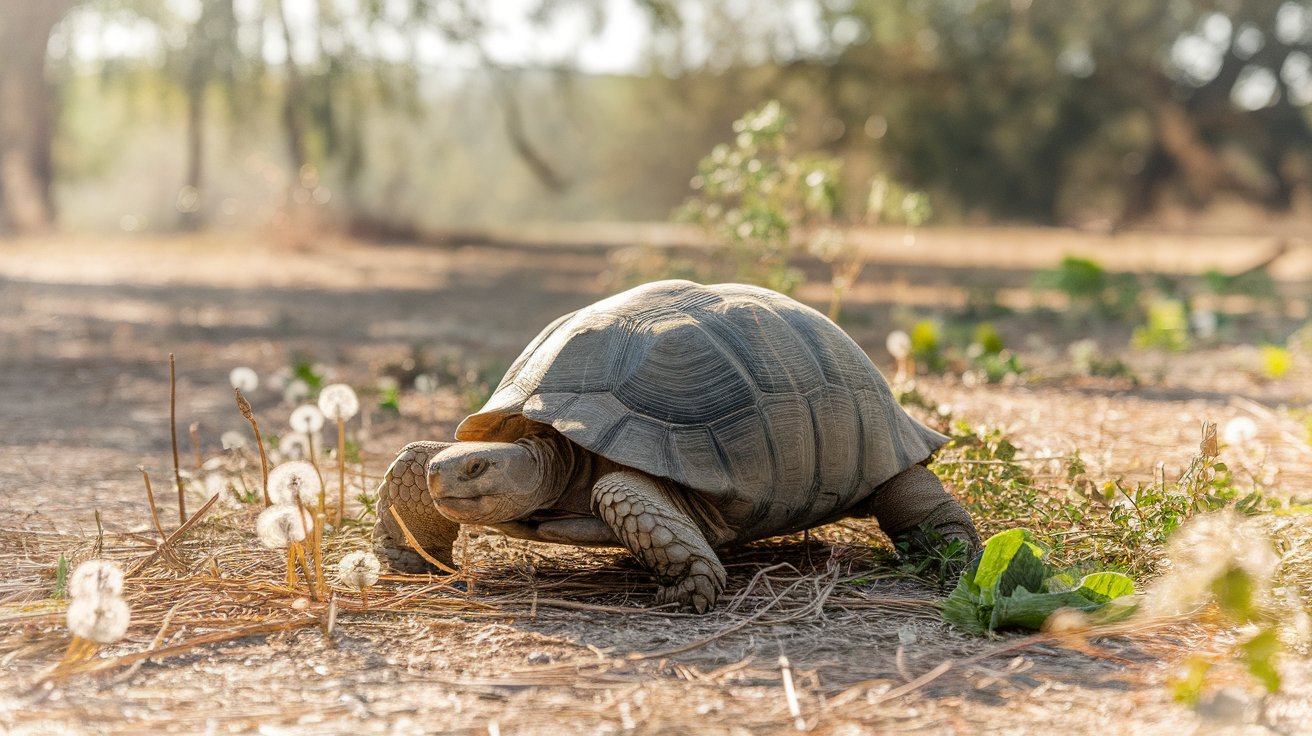Introduction
Understanding the dietary needs of tortoises is crucial for their health and longevity, especially for species like the Russian tortoise. Incorporating a part of a varied diet that includes leafy greens and vegetables such as parsley, which is rich in nutrients but should be given in moderation due to oxalates that can cause kidney issues, is essential. Always ensure to wash the parsley thoroughly before feeding, as this removes harmful pesticides and chemicals, safeguarding your reptile’s health.
It’s also important to recognize what is safe for tortoises to eat. Tortoises can eat a range of greens but should avoid those that are not suitable due to potential health risks. Russian tortoises eat parsley, but it should not be the only green in their diet. Feeding your tortoise parsley can be beneficial if done correctly, enhancing their nutrient intake while ensuring that the food remains part of their diet without overwhelming it with high oxalate content.
Key Takeaways
- Parsley, rich in nutrients but high in oxalates, should be part of a varied diet for tortoises but used in moderation to prevent kidney issues.
- A balanced diet with a variety of greens, including parsley, ensures tortoises receive essential nutrients without overwhelming them with high oxalate content.
- Thoroughly wash the parsley before feeding to remove harmful chemicals, enhancing the safety and health of your reptile.
- Tortoises benefit from a diet that includes not only parsley but also other greens like kale, lettuce, and dandelion greens, promoting overall vitality and preventing nutritional deficiencies.
- While parsley provides significant health benefits, its risks due to oxalate content must be managed by pairing it with low-oxalate greens.
- Always verify the safety of new foods to prevent the risk of poisoning and ensure a healthy environment for your tortoise.
The Tortoise Diet
The diet of a tortoise plays a critical role in maintaining its health and well-being. For pet owners, understanding what to feed your tortoise is essential, particularly for species like the Russian tortoise. Incorporating a variety of greens, vegetables, and occasional fruits ensures they receive necessary nutrients. Including parsley, which parsley also contains vital nutrients, and other alternatives to parsley like tortoises eat cucumbers and tortoises eat tomatoes, can enhance their diet. Tortoises can eat parsley, but it’s important to offer parsley in moderation due to oxalates in parsley. Always sure to wash the parsley thoroughly to maintain your tortoise’s health.
The Importance of a Varied Diet
Diversity in a tortoise’s diet helps prevent health issues and promotes a balanced intake of vitamins and minerals. Foods rich in calcium and vitamin K, such as kale, dandelion greens, and parsley, should be a staple. However, it’s crucial to balance these with other vegetables to avoid overconsumption of oxalates, which can harm tortoise health.
Natural Diet of Russian Tortoises
In their natural habitat, Russian tortoises consume a wide range of leafy greens and flowers. In captivity, mimicking this diet helps maintain their health and mimics natural feeding behaviors. While parsley is safe in moderation, always ensure it’s washed thoroughly to remove any harmful chemicals or pesticides.
Parsley and Its Nutritional Value
Parsley is not just a garnish—it’s packed with nutrients that can benefit the health of tortoises when included in their diet. Rich in vitamins and minerals, fresh parsley can enhance a tortoise’s intake of vitamin C and iron, crucial for their overall vitality. However, due to the presence of oxalic acid, which can affect calcium absorption, it’s crucial to moderate its use. Including parsley in your tortoise’s diet offers a variety of vitamins but parsley should be offered with care, as it can be detrimental to tortoises if not balanced with other vegetables that are high in nutrition and fed in moderation.
Key Nutritional Facts About Parsley for Russian Tortoises
- High Nutritional Value: Parsley is rich in vitamin C and iron, which are crucial for the overall vitality of Russian tortoises, enhancing their immune system and blood health.
- Oxalate Content Considerations: While beneficial, parsley contains oxalates that can inhibit calcium absorption, necessitating moderation in its use to prevent potential health risks.
- Balanced Diet Necessity: To avoid nutrient imbalances, it’s important to pair parsley with low-oxalate greens like lettuce and kale, ensuring Russian tortoises receive a well-rounded diet.
- Herbal Variety: Besides parsley, incorporating other herbs like basil and dandelion greens provides additional vitamins and flavors, supporting digestive health and dietary satisfaction.
This list has been crafted to provide a clear understanding of how parsley and other herbs fit into the diet of Russian tortoises, highlighting both the benefits and necessary precautions to optimize their health.
Herbs in a Tortoise’s Diet
Herbs like parsley, basil, and dandelion greens are great additions to a tortoise’s diet, providing essential nutrients and variety. These herbs contribute not just flavor but also important vitamins that help support the health and digestion of tortoises. It’s vital to balance these with other dietary elements to ensure a nutritious mix that avoids any single nutrient’s dominance.
Oxalate Levels in Parsley
Parsley contains oxalates, which, while manageable, can pose risks if consumed in large quantities. Tortoise owners should be aware of these levels and incorporate parsley judiciously into their pet’s diet. Pairing parsley with low-oxalate greens such as lettuce and kale helps balance the diet, ensuring that tortoises get the benefits without the risks of too much oxalate.
Feeding Parsley to Tortoises
Parsley can be a nutritious addition to a tortoise’s diet, offering hydration and essential nutrients. However, it is crucial to integrate it properly into their dietary regimen. Given its high oxalate content, moderation is key to avoiding health complications, making it essential to balance it with other vegetables and leaves and flowers. Including parsley to your tortoise’s diet as part of a varied intake of greens, such as tortoises eat lettuce and eat basil, enhances their nutritional profile. Tortoises eat mint and eat chives can be part of an occasional treat, ensuring a variety of herbs and vegetables are utilized for the diet for your specific tortoise.
Can Tortoises Eat Parsley?
Tortoises can indeed enjoy parsley as part of their diverse diet. While parsley is safe in small amounts, it should not dominate their food intake. Incorporating a variety of greens and vegetables, such as cucumbers, tomatoes, and lettuce, ensures that tortoises get a balanced mix of nutrients, supporting their overall health and preventing dietary monotony.
Benefits and Risks of Feeding Parsley
Parsley offers significant benefits for tortoises, including vitamins and minerals that support their health. Yet, its high oxalate content poses risks if overconsumed, potentially leading to kidney problems. To mitigate these risks, tortoise owners should serve parsley in small, controlled portions, carefully washing it to remove any pesticides or chemicals, and always pairing it with other suitable greens and vegetables.
“Feeding parsley to tortoises can significantly enhance their nutrient intake, but moderation is essential due to the oxalate content which could pose health risks.” – Dr. Jane Goodall, renowned primatologist and environmentalist.
Other Greens for Russian Tortoises
Russian tortoises thrive on a diet rich in various greens that provide essential nutrients for their growth and overall health. While parsley is a known option, exploring other leafy greens can enhance their dietary regimen and prevent nutritional deficiencies. Incorporating a wide range of vegetables ensures that these tortoises enjoy a balanced and healthful diet.
Basil and Leafy Greens
Basil, along with other leafy greens like kale and lettuce, forms a crucial part of a Russian tortoise’s diet. These greens are packed with vitamins such as vitamin K and calcium, which are vital for their shell and overall health. It’s important to rotate these greens regularly in the tortoise’s diet to provide variety and prevent the risk of oxalate accumulation, which can be harmful in high amounts.
What Tortoises Like to Eat
Russian tortoises have specific preferences when it comes to their diet, showing particular fondness for dandelion greens, cucumbers, and tomatoes, alongside traditional leafy greens. Offering a mix of these foods not only caters to their taste but also covers the nutritional bases necessary for their well-being. Observing which foods your tortoise prefers and how they react to different greens can help tailor a diet that is both enjoyable and healthy for them.
Common Misconceptions about Tortoise Diet
There are many myths and misunderstandings surrounding what tortoises can and cannot eat, leading to confusion and potential health risks. It’s vital to differentiate between what is safe and beneficial and what might be harmful to these creatures. Education and awareness about the dietary needs and restrictions of tortoises are essential for maintaining their health and longevity.
What Tortoises Might Not Eat
Contrary to popular belief, not all greens are suitable for tortoises. Some herbs and vegetables, especially those that are extremely bitter or have strong flavors, are not favored by tortoises and can even cause digestive discomfort. Furthermore, while some greens might be non-toxic, they may not necessarily provide any substantial nutritional value. Owners should focus on providing a diet that includes greens and vegetables that are both nutritious and palatable for tortoises.
Foods Poisonous to Tortoises
It is critical to be aware of which foods are toxic to tortoises to avoid inadvertent poisoning. Foods like avocado, rhubarb, and some beans are known to be harmful and can lead to serious health issues such as kidney damage. Always research thoroughly before introducing any new food into your tortoise’s diet to ensure it is safe. Prioritizing safe and appropriate foods is key to fostering a healthy environment for your tortoise.
[lasso rel=”amazon-24″ id=”5416″]
Conclusion
In conclusion, the dietary management of tortoises, particularly with parsley and other leafy greens, is pivotal for their health and well-being. Parsley, though nutrient-rich, contains oxalates that necessitate moderation to prevent potential kidney issues. It is crucial to wash the parsley thoroughly to remove contaminants, ensuring the safety and health of your turtle or reptile.
While parsley is generally safe, incorporating a diverse range of vegetables like cucumbers, tomatoes, and lettuce—all tortoise favorites—ensures a balanced diet that addresses all nutritional needs. Remember, the key to a healthy tortoise diet lies in variety and moderation, fostering a conducive environment that supports their natural dietary habits and longevity. Always ensure to feed a tortoise foods that are safe for tortoises to maintain their optimal health.


